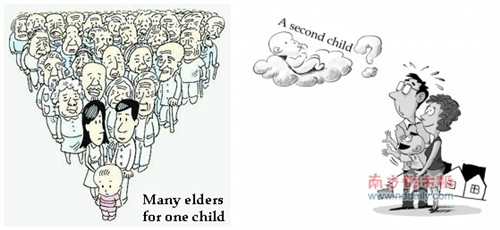(Ecns.cn)--Scores of statistics on China's aging population were released during the meeting of the nation's top legislative body in late August. The statistics formed part of an enforcement inspection report on the Law of the People's Republic of China on the Protection of the Rights and Interests of the Aged, led by Li Jianguo, vice chairman and secretary general of the Standing Committee.
The report caught the attention of international media, as foreign voices flooded in urging China to ease or completely abandon the current One Child Policy.
However, in an interview with Outlook Weekly, Dr. Zhai Zhenwu, vice chairman of the China Population Association and dean of the School of Sociology and Population Studies at Renmin University of China, argued that relaxing the policy is not the only answer to the problems.
Right timing
"Simple calculations can't be used to reach an accurate conclusion to the aging population problem in China," noted Dr. Zhai. Factors such as economic development and a descending birth rate have all led to the aging issue and, under the One Child Policy, the birth rate has dropped even more sharply, he added.
Reconsideration of the current policy framework is called for to optimize family structure, balance gender rates and cater to the public will to bear more children, said Zhai.
Zhai analyzed that proper measures should be initiated based on three factors: because the 30-year history of the current policy has effectively controlled the population figure, some flexibility is allowed for an unprecedented trial; a conflicting population structure should be foreseen and coped with before problems occur; and actions should be taken steadily and coherently to avoid sudden demographic changes.
From the perspective of efficient resource distribution, the increasing land use ratio and food productivity are evidence of higher efficiency, Zhai said.
However, overdependence on overseas resources exists broadly, especially in imports of oil, steel and chemical fertilizer. And considering the food security concerns in recent years, the larger population is enjoying economic prosperity while also enduring its side effects, he added.
Overall, Zhai holds the view that in the future, when the population reaches the peak of 1.5 billion and a zero growth rate, a slow descent is expected in order to reduce pressure on resources and the environment, and to improve the national economy and public welfare.
Aging irreversibility
"First and foremost, whether China relaxes the One Child Policy or not, the general aging trend is a fact. Even if permission for a second child is granted all across the country, the effect on China's aging problem is restricted," said Zhai.
The aging phenomenon is inevitable as the birth rate lowers, which is backed up by experiences in most developed and newly-emerged industrial countries and regions, such as Japan, Korea, Singapore and Taiwan, as well as Iran and Vietnam. What's special about China is that the One Child Policy has accelerated the declining birth rate and sped up the rate of aging.
"Any policy applies to the exact era, corresponding to the public notions of that time," said Zhai. With the modernization, urbanization and industrialization taking place in China, more females are entering the job market, social security plans are gradually being perfected, and the burden on youth to take care of the elderly is decreasing, all of which change the social concept of child breeding.
Even if the policy is relaxed, many couples will not put breeding on their agendas. This leads to the reasonable prediction that the family planning policy might not play any role in confining population growth, added Zhai.
As a solution to the aging problem, Zhai downplayed permission for more children as an effective option. Instead, the key is to establish a systematic social security plan and elder care service industry, by pushing industrial transformation towards an upgraded structure, replacing labor-oriented companies with technology-concentrated firms, and stimulating labor productivity.


















